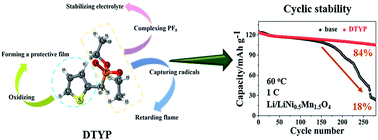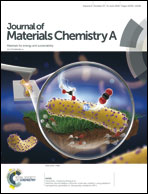Diethyl(thiophen-2-ylmethyl)phosphonate: a novel multifunctional electrolyte additive for high voltage batteries†
Abstract
Carbonate-based electrolytes used in Li-ion batteries encounter various challenges in extreme electrochemical environments, and hence their application requires various additives, especially when used with high voltage cathode materials. These additives are designed to form protective interphases that prevent parasitic carbonate oxidation, while in certain cases they stabilize electrolytes from reduction at anode surfaces or even serve as flame-retardants that postpone the thermal runaway during overcharge. However, most of these additives casts negative effects, lowering ionic conductivity of electrolyte or impairing the compatibility between cathode and electrolyte. An ideal solution of minimizing the presence of these inert molecules is to identify an additive that structurally integrates these multiple functions into a single compound. In this work, we report a novel additive, diethyl(thiophen-2-ylmethyl)phosphonate (DTYP). Its 0.5% presence in a base electrolyte dramatically improves the capacity retention of a high voltage Li-ion cell using LiNi0.5Mn1.5O4 from 18% to 85% after 280 cycles at 1C at 60 °C, increases the endothermic reaction onset temperature from 193 °C to 223 °C, and reduces the self-extinguishing time of the electrolyte from 88 s to 77 s. Thus, such a multifunctional additive presents a cost-efficient solution to the issues often faced in high voltage lithium-ion batteries.

- This article is part of the themed collection: 2018 Journal of Materials Chemistry A HOT Papers


 Please wait while we load your content...
Please wait while we load your content...